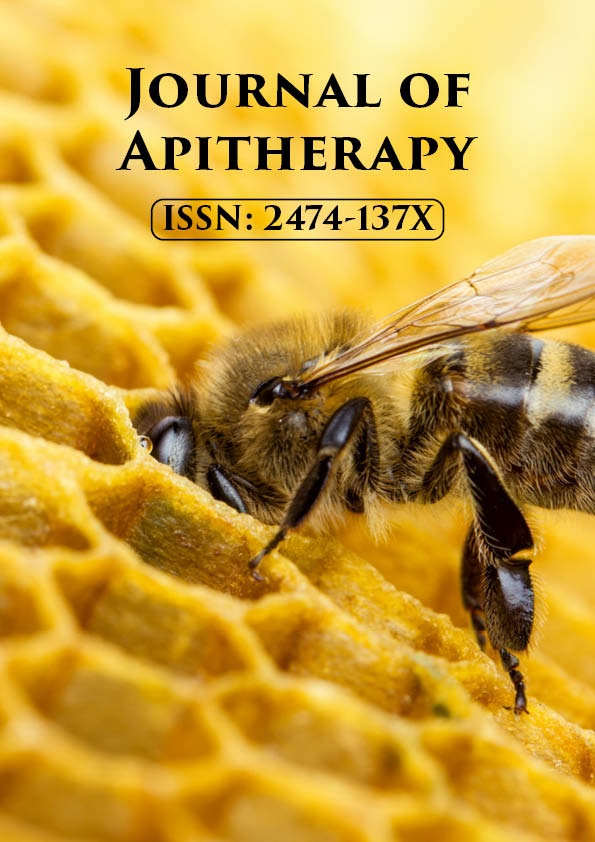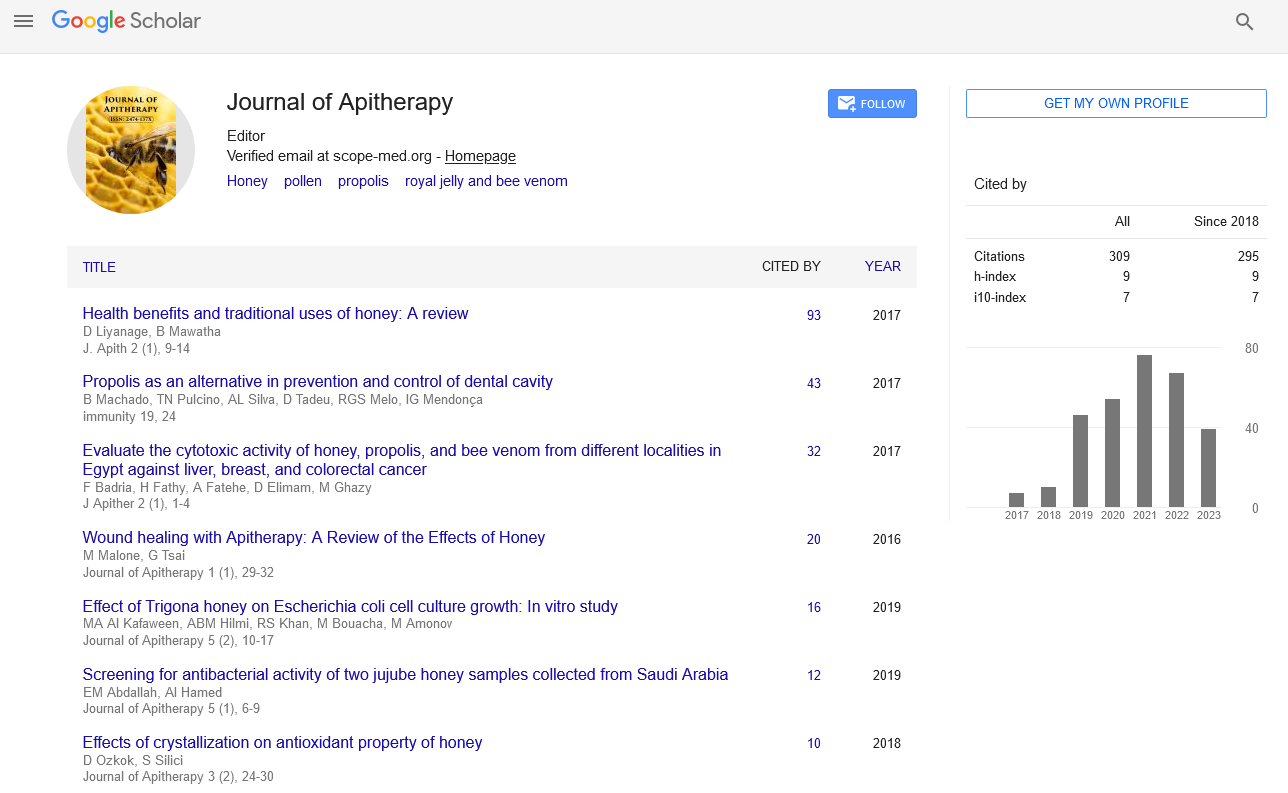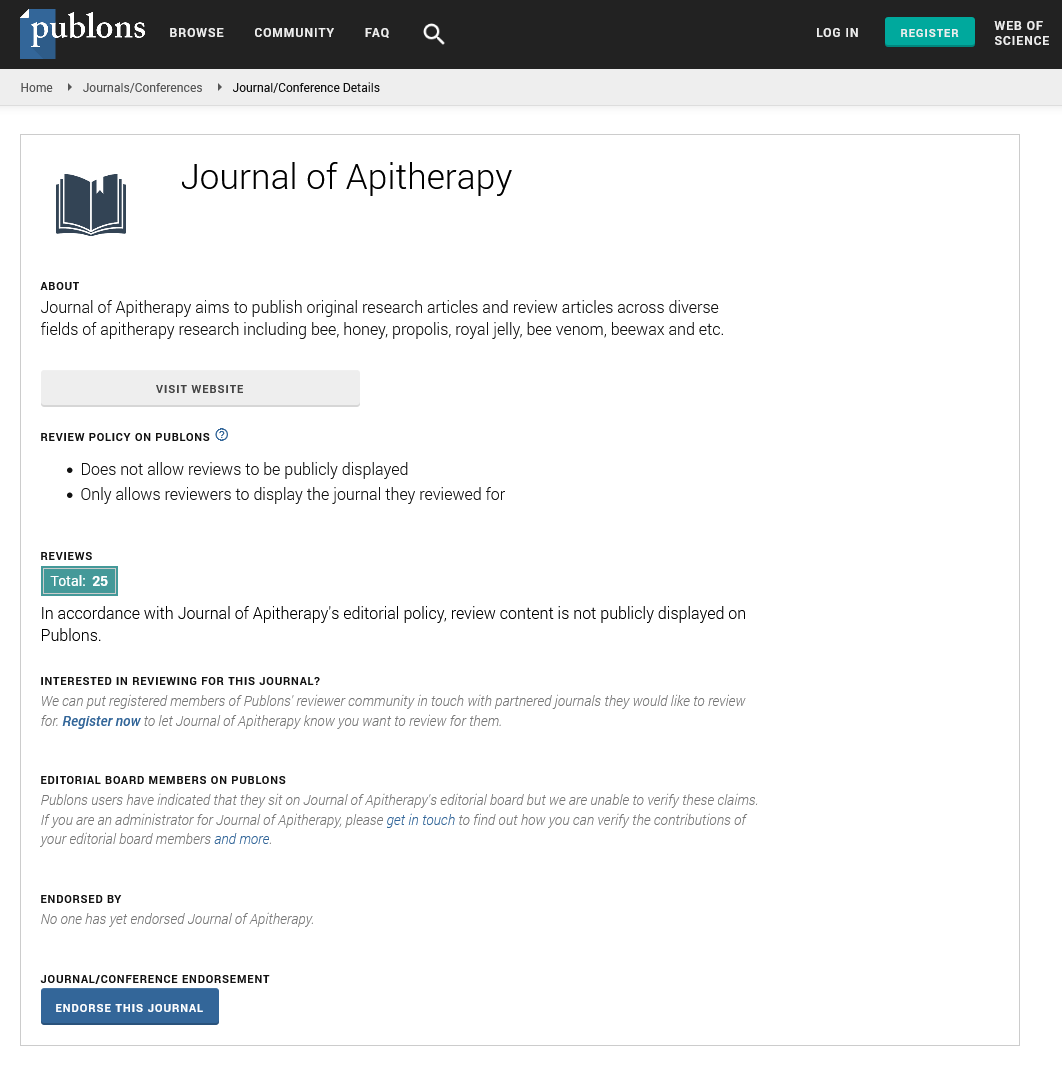Hypothesis - Journal of Apitherapy (2021)
Back to Ancient Remedy: Could Inhalation of Aerosolised-Honey and Propolis Tincture Protect Against the COVID-19 Pandemic?
Yahya Al Naggar1*, Yahya Al Naggar2, Galal Yahya3, Galal Yahya4, Saad Al-Kahtani5 and Stefan Stangaciu62Zoology Department, Martin Luther University of Halle-Wittenberg, Halle, Germany
3Microbiology and Immunology Department, Zagazig University, Al Sharqia, Egypt
4Department of Molecular G-enetics, Technical University of Kaiserslautern, Kaiserslautern, Germany
5Arid Land Agriculture Department, King Faisal University, Al-Ahsa, Saudi Arabia
6Apitherapy Consulting and Trading International SRL, Sat Mereni, Dambovita, Romania
Yahya Al Naggar, Zoology Department, Tanta University, Egypt, Email: yehia.elnagar@science.tanta.edu.eg
Published: 01-Mar-2021
Abstract
The second wave of the COVID-19 pandemic is exacerbating in most of the countries creating a state of international alert. After a year of COVID-19 emergence, while some COVID-19 vaccines are currently being produced and available, new concerns regarding their safety and efficacy are coming up particularly with the emergence of mutated strains of SARS-CoV-2 virus. Here, we propose an alternative, inexpensive and natural approach that could attenuate or/and eliminate the respiratory symptoms of COVID-19 by inhalation of body temperature aerosolized-honey and propolis tincture particularly in developing countries. Vapor inhalation of this mixture might also fight the virus, modulate the immune system, and attenuate the exaggerated inflammatory response of COVID-19 before, during or after it occurs. This strategy could also be important as a home remedy and for healthcare employees since they need to take preventative measures at any time.
Keywords
Honey; Propolis; Covid-19 respiratory symptoms; Apitherapy; Home remedy; Developing countries
Introduction
The COVID-19 pandemic is inflaming a global alarm due to its devastating effects on human health and the world economy. It is much more lethal than influenza and other types of diseases that have had a worldwide impact recently [1]. Patients infected by SARS-CoV-2 develop varying symptoms like dry cough, fever, headache, fatigue, shortness of breath, and diarrhea and some of them show no symptoms at all. In 5% of cases, the disease progresses and may result in acute lung injury (ALI) that is manifested to acute respiratory distress syndrome (ARDS), respiratory failure, heart failure, sepsis, and sudden cardiac arrest within a few days [2,3]. Various public health initiatives have been implemented to reduce the effects of the outbreak, but with limited success as the virus continues to spread. So, we are still wondering, if the worst could still be ahead of us. At least that is the concern that the pandemic of the novel coronavirus SARS-CoV-2 would follow the path of the Spanish flu in 1917 and 1918. At that time, the second wave was bigger and more deadly than the first wave [4].
While some COVID-19 vaccines such as BNT162b2 mRNA and Sinopharm are currently being distributed and available in some developed countries, they are very costly and will not be available to developing countries in the coming months, more over new concerns regarding safety and efficacy of the newly developed and approved vaccines are coming up [5–9], another challenge is the emergence of mutated strains of SARS-CoV-2 virus [10]. Natural products with proven therapeutic and antiviral activity may therefore provide an affordable, safe way to treat the disease [11–14]. Honeybees products are well known for their nutritional and medicinal value and have been used for various therapeutic purposes for decades [15–19]. Many studies suggest promising effects of bee pharmacy against COVID-19 either by direct antiviral effects of their bioactive peroxides, peptides, flavonoids and phenolics or indirect effects due to their immunomodulatory effect on the host immune system and interfering with host inflammatory response aroused by COVID-19 infection [20–24].
Cough is typically associated with upper respiratory infections and one of the major symptoms of COVID-19. Efficacy of buckwheat honey compared to dextromethorphan as treatment in children with nocturnal cough and trouble sleeping due to upper respiratory tract infection has been documented [25]. In addition, the importance of Tualang honey (TH) in the reduction of acute respiratory symptoms such as cough, rhinitis and sore throat was assessed in 2007 [26]. Malaysian hajj pilgrims who were usually associated with these symptoms while conducting hajj were the studied population. Oral intake of honey twice daily helped to alleviate respiratory symptoms among pilgrims. Honey inhalation in paediatrics has been shown to be effective in treating acute bronchial asthma [27].
Hypothesis
We assume that inhalation of aerosolized-honey and propolis tincture could be used as a prophylactic measure or/and relieve COVID-19 respiratory symptoms. Honey has been recommended as a first-line treatment for cough due to upper respiratory tract infection by the National Institute for Health and Care Excellence (NICE) and Public Health England (PHE), which is the main well-known symptom of COVID-19 [28], variable concentrations of Manuka honey, on the other hand, unexpectedly modulate the release of cytokines, chemokines and matrix-degrading enzymes that control inflammatory and immune responses [29]. Currently, drugs that regulate cytokine storms and soften hyperinflammation such as dexamethasone [30] are commonly considered to protect against acute respiratory distress syndrome (ARDS) as the main cause of death due to severe COVID-19 infection [31]. Propolis also provides a concentrated dosage of therapeutic flavonoids and phenolic compounds [18] that on the one hand, interact with the virus’s maturation and replication machinery and on the other hand, mitigate the possible exaggerated inflammatory response of COVID-19.
Before the first treatment session, the patient will be examined by a medical or health practitioner. Based on the patient’s medical history, the number of treatment sessions will be determined. The doctor or naturopath will then perform a 10-minute test of inhalation of pollen free aerosolised-honey and propolis tincture with the patient. The test is vital to the exclusion of any allergic or anaphylactic reactions to this mixture. Twenty-four hours later, the first therapy application for the patient can be performed. The concentrations, preparation of aerosolized-honey and propolis tincture is shown in (Figure 1).
To reduce the loss of propolis substances that adhere to the inner walls of the container of the nebulizer, 10 drops of propolis tincture 20-30% is added to 0,5 ml. of honey and then is well mixed (homogenized). After this first homogenization is realized, 3 ml. of saline solution is added and the second homogenization is made, before introducing the final mixture in the nebulizer [32].
Discussion
Management of pulmonary diseases requires the external interventions to improve the functions of the respiratory system especially in case of complicated diseases like viral infections of lungs where mechanical ventilation and extracorporeal membrane oxygenation side by side to antiviral therapeutics are lifesaving to prevent case progression to Acute Respiratory Failure (ARF) [33–36]. COVID-19 infection manifests as mild symptoms then progress in severely affected patients into pneumonia and respiratory failure or even multiple organ failure [37–39]. Steam inhalation is traditionally used as a home remedy for common colds and upper respiratory tract infections [40] with some restrictions to its safety to children [41]. Additionally, a variety of studies and publications have shown the significance of alcohol inhalation in the treatment of pulmonary odema and addressed its possible function as a disinfectant of SARS-CoV-2 (COVID-19) in human respiratory tract [42,43]. Alcohol inhalation can, however, have an inflammatory and harmful impact on patients [44].
Apitherapy (Fr. apithérapie, cf. Lat. apis – bee, Ngr. therapeia – treatment) is based on the use of the main beehive products (honey, pollen, bee bread, beeswax, royal jelly, propolis and bee venom) in preventing and treating various diseases, as well as in increasing the resistance of the human body [11,45,46]. The medicinal use of beehive products is known since the dawn of time, but its academic and scientific dimension has appeared in Europe about 70 years ago. In our study we recommend wide application of apitherapy sessions, since apitherapy improve the efficiency of respiratory system [46,47]. Apitherapy can be applied from pre-natal stage to the last day of life and rarely develop side effects, leading to a profound improvement of clinical parameters. It usually targets the causes of the disease and thus relieves the symptoms e.g., running nose, sneezing, coughing, vomiting and diarrhea. Additionally, the so-called functional diseases are responding best to apitherapy when the changes in the structure of the organs are not so deep. Most of the inflammations respond best to apitherapy [45].
Aerosolized or/and vapors-based honey and propolis mixture of apitherapists, might combat the virus and modulate the immune system on the one hand and attenuate the exaggerated inflammatory response of COVID-19 on the other hand. Honey could bring energy to the vibratile cells that moves the cilia that are moving the mucus from inside to outside of the lung, makes the mucus in the lungs more fluid and thus it helps the expectoration [48]. It has been also found to be superior to usual care for the improvement of symptoms of upper respiratory tract infections[ 49]. On the other hand, propolis helps the cells to survive better in hypoxemia conditions due to a better functioning of the mitochondria [50]. More interestingly, it has been revealed by molecular docking the profound binding affinity of 14 selected phenolics and terpenes present in honey and propolis against the main protease (Mpro) and RNA dependent RNA polymerase (RdRp) enzymes of the novel 2019-nCoV coronavirus. Of these compounds, p-coumaric acid, ellagic acid, kaemferol and quercetin has the strongest interaction with the 2019-nCoV target enzymes, and they may be considered as an effective 2019- nCoV inhibitors [51].
Conclusion
The proposed application could, therefore, help in the prophylaxis against seasonal allergy and asthma; beehive products can also prevent and/or treat many co-infections and co-morbidities like diabetes, cardiovascular diseases, and obesity which are conditions that lead to more severe complications upon COVID-19 infection. It may also be necessary for healthcare staff since they may need to take immediate preventative action at any time.
References
- Vardeny O, Madjid M, Solomon SD. Applying the lessons of influenza to covid-19 during a time of uncertainty. Circulation. 2020; 141(21):1667-9.
- Huang C, Wang Y, Li X, Ren L, Zhao J, Hu Y, et al. Clinical features of patients infected with 2019 novel coronavirus in Wuhan, China. Lancet. 2020; 395(10223):497-506.
- Preskorn SH. The 5% of the population at high risk for severe covid-19 infection is identifiable and needs to be taken into account when reopening the economy. J Psychiatr Pract. 2020; 26(3):219-27.
- Garcia S. Pandemics and traditional plant-based remedies. A historical-botanical review in the era of Covid19. Front Plant Sci. 2020; 11.
- Polack FP, Thomas SJ, Kitchin N, Absalon J, Gurtman A. Safety and efficacy of the BNT162b2 mRNA Covid-19 vaccine. N Engl J Med. 2020; NEJMoa2034577.
- Folegatti PM, Ewer KJ, Aley PK, Angus B, Becker S. Safety and immunogenicity of the ChAdOx1 nCoV-19 vaccine against SARS-CoV-2: A preliminary report of a phase 1/2, single-blind, randomised controlled trial. Lancet. 2020; 396(10249):467-78.
- Knoll MD, Wonodi C. Oxfordâ??AstraZeneca COVID-19 vaccine efficacy. Lancet. 2020.
- Ramasamy MN, Minassian AM, Ewer KJ, Flaxman AL, Folegatti PM. Safety and immunogenicity of ChAdOx1 nCoV-19 vaccine administered in a prime-boost regimen in young and old adults (COV002): A single-blind, randomised, controlled, phase 2/3 trial. Lancet. 2020; 396(10267):1979-93.
- Voysey M, Clemens SAC, Madhi SA, Weckx LY, Folegatti PM. Safety and efficacy of the ChAdOx1 nCoV-19 vaccine (AZD1222) against SARS-CoV-2: An interim analysis of four randomised controlled trials in Brazil, South Africa, and the UK. Lancet. 2020.
- Brainard J. Surveys of infectious disease experts aim to predict COVID-19â??s toll. Science (80). 2020.
- Gupta RK, Stangaciu S. Apitherapy: Holistic Healing Through the Honeybee and Bee Products in Countries with Poor Healthcare System. In: Beekeeping for Poverty Alleviation and Livelihood Security. Dordrecht: Springer Netherlands; 2014; 413-46.
- Chinsembu KC. Coronaviruses and Natureâ??s Pharmacy for the Relief of Coronavirus Disease 2019. Rev Bras Farmacogn. 2020; 30(5):603-21.
- Lin LT, Hsu WC, Lin CC. Antiviral natural products and herbal medicines. J Tradit Complement Med. 2014; 4(1):24-35.
- Newman DJ, Cragg GM. Natural products as sources of new drugs over the nearly four decades from 01/1981 to 09/2019. J Nat Prod. 2020; 83(3):770-803.
- Patel S, Cichello S. Manuka honey: An emerging natural food with medicinal use. Nat Products Bioprospect. 2013; 3(4):121-8.
- Schnitzler P, Neuner A, Nolkemper S, Zundel C, Nowack H. Antiviral activity and mode of action of propolis extracts and selected compounds. Phyther Res. 2010; 24:20-8.
- Lee JA, Kim YM, Hyun PM, Jeon JW, Park JK. Honeybee (Apis mellifera) Venom reinforces viral clearance during the early stage of infection with porcine reproductive and respiratory syndrome Virus through the Up-Regulation of Th1-Specific Immune Responses. Toxins (Basel). 2015; 7(5):1837-53.
- Al Naggar Y, Sun J, Robertson A, Giesy JP, Wiseman S. Chemical characterization and antioxidant properties of Canadian propolis. J Apic Res. 2016; 55(4):305-14.
- Socarras KM, Theophilus PAS, Torres JP, Gupta K, Sapi E. Antimicrobial activity of bee venom and melittin against borrelia burgdorferi. Antibiot (Basel, Switzerland). 2017; 6(4).
- Berretta AA, Silveira MAD, Cóndor Capcha JM, De Jong D. Propolis and its potential against SARS-CoV-2 infection mechanisms and COVID-19 disease. Biomed Pharmacother. 2020; 131:110622.
- Yang W, Hu F, Xu X. Bee venom and SARS-CoV-2. Toxicon. 2020; 181:69-70.
- Kumar V, Dhanjal JK, Kaul SC, Wadhwa R, Sundar D. Withanone and caffeic acid phenethyl ester are predicted to interact with main protease (M pro ) of SARS-CoV-2 and inhibit its activity. J Biomol Struct Dyn. 2020; 1-13.
- Lima WG, Brito JCM, Cruz Nizer WS. Bee products as a source of promising therapeutic and chemoprophylaxis strategies against COVID19 (SARS-CoV). Phyther Res. 2020; ptr.6872.
- Al Naggar Y, Giesy JP, Abdel-Daim MM, Javed Ansari M, Al-Kahtani SN. Fighting Against the second Wave of COVID-19: Can Honeybee products help protect against the pandemic? Saudi J Biol Sci. 2020.
- Paul IM. Effect of honey, dextromethorphan, and no treatment on nocturnal cough and sleep quality for coughing children and their parents. Arch Pediatr Adolesc Med. 2007; 161(12):1140.
- Sulaiman SA, Hasan H, Deris ZZ, Wahad MSA, Yusof RC. The benefit of tualang honey in reducing acute respiratory symptons among malaysian hajj pilgrims: A preliminary study. J ApiProduct ApiMedical Sci. 2011; 3(1):38â??44.
- Kamaruzaman NA, Sulaiman SA, Kaur G, Yahaya B. Inhalation of honey reduces airway inflammation and histopathological changes in a rabbit model of ovalbumin-induced chronic asthma. BMC Complement Altern Med. 2014; 14(1):176.
- Wölfel R, Corman VM, Guggemos W, Seilmaier M, Zange S. Virological assessment of hospitalized patients with COVID-2019. Nature. 2020.
- The Effect of Manuka Honey on dHL-60 Cytokine, Chemokine, and Matrix-Degrading Enzyme Release under Inflammatory Conditions. Med One. 2019.
- Dexamethasone in Hospitalized Patients with Covid-19 Preliminary Report. N Engl J Med. 2020.
- Mehta P, McAuley DF, Brown M, Sanchez E, Tattersall RS, Manson JJ. COVID-19: Consider cytokine storm syndromes and immunosuppression. Lancet. 2020; 395(10229):1033-4.
- Donia C. The X-th. Romanian apitherapy congress, Sibiu, Romania. In 2017.
- Griffiths MJD, McAuley DF, Perkins GD, Barrett N, Blackwood B, et al. Guidelines on the management of acute respiratory distress syndrome. BMJ Open Respir Res. 2019; 6(1):e000420.
- Marini JJ, Gattinoni L. Management of COVID-19 respiratory distress. J American Med Asso. 2020; 323(22):2329.
- Lepper PM, Muellenbach RM. Mechanical ventilation in early COVID-19 ARDS. EClinicalMedicine. 2020; 28:100616.
- Fan E, Beitler JR, Brochard L, Calfee CS, Ferguson ND. COVID-19-associated acute respiratory distress syndrome: Is a different approach to management warranted? Lancet Respir Med. 2020; 8(8):816-21.
- Wang T, Du Z, Zhu F, Cao Z, An Y, Gao Y, et al. Comorbidities and multi-organ injuries in the treatment of COVID-19. Lancet. 2020; 395(10228):e52.
- Mokhtari T, Hassani F, Ghaffari N, Ebrahimi B, Yarahmadi A. COVID-19 and multiorgan failure: A narrative review on potential mechanisms. J Mol Histol. 2020; 51(6):613â??28.
- Zaim S, Chong JH, Sankaranarayanan V, Harky A. COVID-19 and multiorgan response. Curr Probl Cardiol. 2020; 45(8):100618.
- Himdani S Al, Javed MU, Hughes J, Falconer O, Bidder C. Home remedy or hazard? Management and costs of paediatric steam inhalation therapy burn injuries. Br J Gen Pract. 2016; 66(644):e193â??9.
- Brewster CT, Choong J, Thomas C, Wilson D, Moiemen N. Steam inhalation and paediatric burns during the COVID-19 pandemic. Lancet. 2020; 395(10238):1690.
- Shintake T. Possibility of disinfection of SARS-CoV-2 (COVID-19) in Human respiratory tract by controlled ethanol vapor inhalation. 2020.
- Harris M. An urgent impetus for action: Safe inhalation interventions to reduce COVID-19 transmission and fatality risk among people who smoke crack cocaine in the United Kingdom. Int J Drug Policy. 2020; 83:102829.
- Winstock AR, Winstock CJ, Davies EL. Inhaling alcohol vapour or mist: An international study of use, effects and harms. Int J Drug Policy. 2020; 85:102920.
- Stangaciu S. What is apitherapy? p. www.apitherapy.com.
- Hellner M, Winter D, von Georgi R, Münstedt K. Apitherapy: Usage and experience in german beekeepers. Evidence-Based Complement Altern Med. 2008; 5(4):475-9.
- Münstedt K, Männle H. Seasonal allergic rhinitis and the role of apitherapy. Allergol Immunopathol (Madr). 2020; 48(6):582â??8.
- Bustamante-Marin XM, Ostrowski LE. Cilia, Mucociliary Clearance. Cold Spring Harb Perspect Biol. 2017; 9(4):a028241.
- Abuelgasim H, Albury C, Lee J. Effectiveness of honey for symptomatic relief in upper respiratory tract infections: A systematic review and meta-analysis. BMJ Evidence-Based Med. 2020; bmjebm-2020-111336.
- Farooqui T. Beneficial effects of propolis on human health and neurological diseases. Front Biosci. 2012; E4(1):779.
- Shaldam, Moataz A, Yahya, Galal, Mohamed. In Silico screening of potent bioactive compounds from honey bee products against covid-19 target enzymes.







